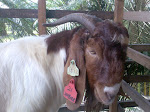- Registered Fullblood Buck (Pejantan matang dgn pedigree cert, range berat 60-90kg) RM2800
- Registered FullBlood Buck (Pejantan matang dgn pedigree cert, range berat 35-45kg) RM2500
- Registered FullBlood Buck (Pejantan matang dgn pedigree cert, range berat 28-35kg) RM2300
- Registered FullBlood Doe (Betina matang dgn pedigree cert, range berat 22-30kg) RM2100
- Unregistered FullBlood Doe (Betina matang tanpa sijil kelahiran, range berat 22-30kg) RM1900
- Purebred Doe (F5 keatas, range berat 25-30kg) RM1400
- F4/F5 brown head matured doe (range berat 22-30kg) RM1300
- F4/F5 white head matured doe (range berat 22-30kg) RM1200
- F1/F2 matured doe RM750
Kambing under "Slaughtering Protocol" (utk pembelian min 200 ekor):
- Boer (35kg) RM470
- feral (30kg) RM410
- Anak boer lepas cerai susu (Jantan) RM390
- Anak boer lepas cerai susu (Betina) RM580
Note: Kambing under classification slaughtering protocol adalah kambing2 jantan pelbagai spec yg telah dipotong "anu"nya, hanya utk sembelihan daging. Begitu juga anak2 kambing yg baru lepas cerai susu, hanya utk "fattening program" seterusnya sembelihan daging kecuali anak boer betina. Pembeli boleh terus ambil setibanya di KLIA.








